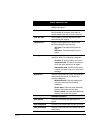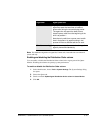
C-14
The following table shows how agent positions are calculated for each distribution algorithm.
The descriptions apply separately to primary agents and to each tier of overflow agents.
Algorithm Agent positions
Top down Agents’ positions are ordered by their order in
the queue and do not change.
Round robin Agents’ positions are reordered according to
which agent answered the previous queue call.
Whenever an agent answers a queue call, the
next agent down in the list becomes 1, the agent
after that becomes 2, and so on. When the
bottom of the queue is reached, the order
continues from the top down until it meets the
agent who answered the most recent call.
Longest idle agent Agent positions are ordered according to the
length of time without being in an Active state.
The agent who has gone the longest without
being Active inbound is in position 1.
Note that talking on non-queue calls and being
in the On Break personal status place an agent
in the Standby state, so that the time since the
agent was Active continues to increase.
Likewise, Wrap-up is not an Active state, so
agents' wrap-up time also increases their “idle”
time. Only receiving a queue call makes an
agent Active and resets the agent's “idle” time.
An agent's position is reduced by 1 whenever an
agent with a longer time since being Active
receives or places a queue call. The only way
for an agent's position to increase is for the
agent to receive a queue call.
Fewest calls Agent positions are ordered according to which
agent has received the fewest queue calls
during the current display period. The agent who
has received the fewest queue calls since the
beginning of the shift is at position 1.
Note that the length of time spent on a queue
call is not significant for adjusting position, only
the number of queue calls participated in.


















